11 03 2015
Braindump2go New Released Microsoft 70-467 Dumps Free Share (11-20)
Quick and Effective Microsoft 70-467 Exam Preparation Options – Braindump2go new released 70-467 Exam Dumps Questions! Microsoft Official 70-467 relevant practice tests are available for Instant downloading at Braindump2go! PDF and VCE Formates, easy to use and install! 100% Success Achievement Guaranteed!
Vendor: Microsoft
Exam Code: 70-467
Exam Name: Designing Business Intelligence Solutions with Microsoft SQL Server 2012 Exam
QUESTION 11
You are designing a subscription strategy for a SQL Server Reporting Services (SSRS) report. You have an application that populates a table with user-specific subscription schedules and report formats.
You need to ensure that users can receive reports by email according to their preferences.
What should you do? (More than one answer choice may achieve the goal. Select the BEST answer.)
A. Create a standard subscription for each record in the table.
B. Create a data-driven subscription for each record in the schedule table.
C. Create one data-driven subscription. Schedule the subscription to frequently retrieve user
preferences.
D. Create a standard subscription for each subscription schedule.
Answer: C
QUESTION 12
You are modifying a SQL Server Reporting Services (SSRS) report for a SQL Server Analysis Services (SSAS) cube.
The report defines a report parameter of data type Date/Time with which users can filter the report by a single date. The parameter value cannot be directly used to filter the Multidimensional Expressions (MDX) query for the dataset.
You need to ensure that the report displays data filtered by the user-entered value.
You must achieve this goal by using the least amount of development effort.
What should you do? (More than one answer choice may achieve the goal. Select the BEST answer.)
A. Edit the dataset query parameter. Change the Value property of the report parameter to an
expression that uses the same format as the date dimension member key value.
B. Edit the dataset query parameter. Change the Name property of the dataset query parameter
so that it points to a name value for each date dimension member.
C. Edit the dataset query parameter. Create a subcube subquery that uses the StrToSet MDX
function and accepts the report parameter value.
D. Change the dataset query to Transact-SQL (T-SQL).
Use the OPENROWSET function to query the cube.
Output the cube results to the T-SQL query and use a Convert function to change the report
parameter value into the same format as the date dimension member.
Answer: A
QUESTION 13
You administer a SQL Server Reporting Services (SSRS) instance in native mode.
You need to assign a predefined role that meets the following requirements:
– Members of the role must be able to update shared data sources.
– Members of the role must not be able to consume reports or manage subscriptions.
– The role must provide only the minimum permissions required.
Which role should you assign? (More than one answer choice may achieve the goal. Select the BEST answer.)
A. the Content Manager role
A. the Read and Process role
B. the Publisher role
D. the Browser role
Answer: C
QUESTION 14
You are designing a strategy for an enterprise reporting solution that uses SQL Server Reporting Services (SSRS).
Many of the SSRS reports will use common utilities and functions, including the following:
– Report utility functions and business logic in code
– Standardized report formatting properties such as fonts and colors for report branding Formatting may change and new functions may be added as the reporting solution evolves.
You need to create a strategy for deploying the formatting and code across the entire enterprise reporting solution.
You must also ensure that reports can be easily updated to reflect formatting and function changes.
What should you do? (More than one answer choice may achieve the goal. Select the BEST answer.)
A. Create a report as a template. Apply standardized formatting to the template.
Store code in the Code section of the template.
B. Build a web service that retrieves formatting properties and runs code.
Call the web service through a report dataset.
C. Store the formatting properties and code in database objects.
Use stored procedures to populate a default value for report parameters and map each
parameter to a corresponding formatting property.
D. Create an assembly that contains formatting properties and code.
Deploy the assembly on the Reporting Server and reference the assembly from each report.
Answer: D
QUESTION 15
Drag and Drop Questions
You are designing a dataset for a SQL Server Reporting Services (SSRS) report.
The report includes the report items displayed in the following graphic.
The dataset is sourced from a commonly used stored procedure in an inventory data mart hosted in a SQL Azure database. It returns the status for all products across all storage sites.
The report must display data for the storage site that is selected by the Site report parameter.
You cannot change the stored procedure code.
You need to filter the dataset to use only data specific to the selected site.
How should you configure the filter? To answer, drag the appropriate expression or expressions to the correct location or locations in the answer area. (Answer choices may be used once, more than once, or not all.)
Answer:
Explanation:
Note:
To set a filter on the dataset
Open a report in Design view.
Right-click a dataset in the Report Data pane and then click Dataset Properties. The Dataset Properties dialog box opens.
Click Filters. This displays the current list of filter equations. By default, the list is empty.
Click Add. A new blank filter equation appears.
In Expression, type or select the expression for the field to filter. To edit the expression, click the expression (fx) button.
Box 1: Here we use the Fields expression.
From the drop-down box, select the data type that matches the type of data in the expression you created in step 5.
In the Operator box, select the operator that you want the filter to use to compare the values in the Expression box and theValue box. The operator you choose determines the number of values that are used from the next step.
Box 2: we test for equality.
In the Value box, type the expression or value against which you want the filter to evaluate the value in Expression.
Box 3: we compare to the value of the Parameter named Site.
Click OK.
Reference: How to: Add a Filter (Reporting Services)
QUESTION 16
Hotspot Questions
You are designing a SQL Server Integration Services (SSIS) package configuration strategy.
The package configuration must meet the following requirements:
– Include multiple properties in a configuration.
– Support several packages with different configuration settings.
You need to select the appropriate configuration.
Which configuration type should you use? To answer, select the appropriate option from the drop-down list in the dialog box.
Answer:
Explanation:
Package Configuration Types
The following table describes the package configuration types.
– SQL Server table
A table in a SQL Server database contains the configuration. The table can include multiple configurations.
– XML configuration file
An XML file contains the configurations. The XML file can include multiple configurations.
– Environment variable
An environment variable contains the configuration.
– Registry entry
A Registry entry contains the configuration.
– Parent package variable
A variable in the package contains the configuration.
This configuration type is typically used to update properties in child packages.
Reference: Package Configurations
QUESTION 17
You are designing a SQL Server Integration Services (SSIS) solution.
The solution will contain an SSIS project that includes several SSIS packages.
Each SSIS package will define the same connection managers and variables.
You have the following requirements:
– Ensure that the deployment model supports changing the content of connection strings by using parameters at execution time.
– Ensure that the deployment model automatically starts from calls to the catalog.start_execution stored procedure in the SSISDB database.
– Maximize performance at execution time.
– Minimize development effort.
You need to design a solution that meets the requirements.
What should you do? (More than one answer choice may achieve the goal. Select the BEST answer.)
A. Use a project deployment model.
Modify connection manager properties to use project parameters.
Ensure that the SSISDB database is created.
B. Use a project deployment model.
Configure connections in an XML configuration file referenced by an environment variable
that corresponds to the SQL Server environment of each SSIS package.
C. Use a package deployment model.
Use a SQL Server package configuration with a common filter.
Change the contents of the SSIS Configurations table at runtime.
D. Use a package deployment model.
Save each SSIS package to a file share that can be accessed from all environments.
Answer: A
QUESTION 18
Drag and Drop Questions
You are creating a SQL Server Integration Services (SSIS) package to populate a fact table from a source table.
The fact table and source table are located in a SQL Azure database.
The source table has a price field and a tax field.
The OLE DB source uses the data access mode of Table.
You have the following requirements:
– The fact table must populate a column named TotalCost that computes the sum of the price and tax columns.
– Before the sum is calculated, any records that have a price of zero must be discarded.
You need to create the SSIS package in SQL Server Data Tools.
In what sequence should you order four of the listed components for the data flow task? (To answer, move the appropriate components from the list of components to the answer area and arrange them in the correct order.)
Answer:
Explanation:
– You configure a Data Flow task by adding components to the Data Flow tab. SSIS supports three types of data flow components:
Sources: Where the data comes from
Transformations: How you can modify the data
Destinations: Where you want to put the data
– Creating a data flow includes the following steps:
– Adding one or more sources to extract data from files and databases, and add connection managers to connect to the sources.
– Adding the transformations that meet the business requirements of the package. A data flow is not required to include transformations.
Some transformations require a connection manager. For example, the Lookup transformation uses a connection manager to connect to the database that contains the lookup data.
– Connecting data flow components by connecting the output of sources and transformations to the input of transformations and destinations.
– Adding one or more destinations to load data into data stores such as files and databases, and adding connection managers to connect to the data sources.
– Configuring error outputs on components to handle problems. At run time, row-level errors may occur when data flow components convert data, perform a lookup, or evaluate expressions.
For example, a data column with a string value cannot be converted to an integer, or an expression tries to divide by zero. Both operations cause errors, and the rows that contain the errors can be processed separately using an error flow.
– Include annotations to make the data flow self-documenting.
– The capabilities of transformations vary broadly. Transformations can perform tasks such as updating, summarizing, cleaning, merging, and distributing data. You can modify values in columns, look up values in tables, clean data, and aggregate column values.
– The Data Flow task encapsulates the data flow engine that moves data between sources and destinations, and lets the user transform, clean, and modify data as it is moved. Addition of a Data Flow task to a package control flow makes it possible for the package to extract, transform, and load data.
A data flow consists of at least one data flow component, but it is typically a set of connected data flow components: sources that extract data; transformations that modify, route, or summarize data; and destinations that load data.
QUESTION 19
Drag and Drop Questions
You are designing a SQL Server Integration Services (SSIS) package to execute 12 Transact-SQL (T-SQL) statements on a SQL Azure database.
The T-SQL statements may be executed in any order.
The T-SQL statements have unpredictable execution times.
You have the following requirements:
– The package must maximize parallel processing of the T-SQL statements.
– After all the T-SQL statements have completed, a Send Mail task must notify administrators.
You need to design the SSIS package.
Which three actions should you perform in sequence? (To answer, move the appropriate actions from the list of actions to the answer area and arrange them in the correct order.)
Answer:
Explanation:
Box 1: Add a Sequence container to the control flow.
Box 2: Add 12 Execute SQL tasks to the Sequence container and configure the tasks.
Box 3: Add a Send mail task to the control flow. Add a precedence constraint for Completion to the to the Sequence container and link it to the Send Mail task.
Note:
The Sequence container defines a control flow that is a subset of the package control flow. Sequence containers group the package into multiple separate control flows, each containing one or more tasks and containers that run within the overall package control flow.
Reference: Sequence Container
QUESTION 20
Hotspot Questions
You are configuring the partition storage settings for a SQL Server Analysis Services (SSAS) cube.
The partition storage must meet the following requirements:
– Optimize the storage of source data and aggregations in the cube.
– Use proactive caching.
– Drop cached data that is more than 30 minutes old.
– Update the cache when data changes, with a silence interval of 10 seconds.
You need to select the partition storage setting.
Which setting should you select? To answer, select the appropriate setting in the answer area.
Answer:
Explanation:
http://msdn.microsoft.com/en-us/library/ms175646.aspx
Low Latency MOLAP
Detail data and aggregations are stored in multidimensional format. The server listens for notifications of changes to the data and switches to real-time ROLAP while MOLAP objects are reprocessed in a cache. A silence interval of at least 10 seconds is required before updating the cache. There is an override interval of 10 minutes if the silence interval is not attained. Processing occurs automatically as data changes with a target latency of 30 minutes after the first change.
This setting would typically be used for a data source with frequent updates when query performance is somewhat more important than always providing the most current data. This setting automatically processes MOLAP objects whenever required after the latency interval. Performance is slower while the MOLAP objects are being reprocessed.
Braindump2go Promises All our customers: 100% All Exams Pass Or Full Money Back! Our experts have complied the fail proof 70-467 Exam content to help all candidates pass your 70-467 certification exam easily in the first attempt and score the top possible grades too.Do you want to sucess? Come to Braindump2go and our experts team will tell you what you need to do! 70-467 Exam Dumps Full Version Download:
http://www.braindump2go.com/70-467.html
Microsoft Official Exam Center New Released 70-467 Practice Exam Questions Free Download from Braindump2go (1-10) New Updated Version: Free Microsoft 70-467 Dumps From Braindump2go 100% Guarantee Your Success (21-30)
![1[10] 1[10]](http://examgod.com/bdimages/1d0d4780ce23_E070/110.png)
![wps8D89.tmp_thumb[4] wps8D89.tmp_thumb[4]](http://examgod.com/bdimages/1d0d4780ce23_E070/wps8D89.tmp_thumb4_thumb.png)
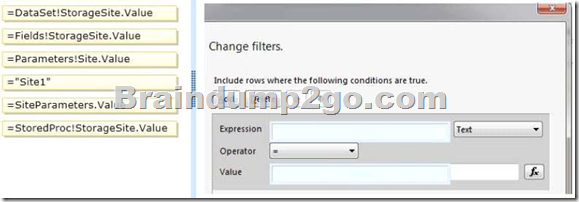
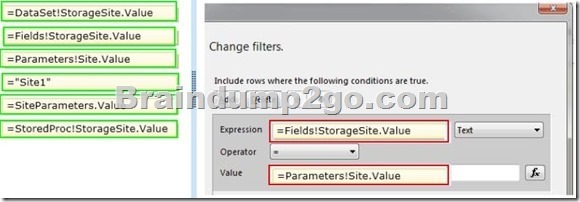
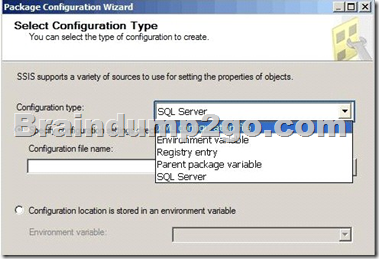
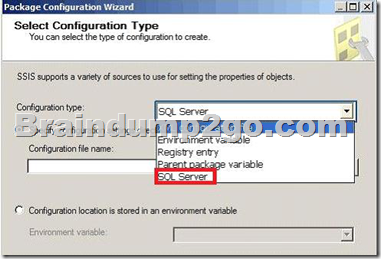


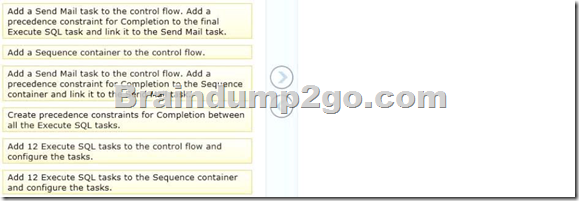
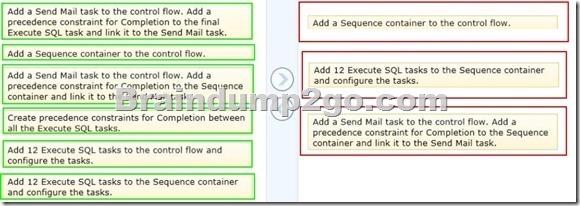
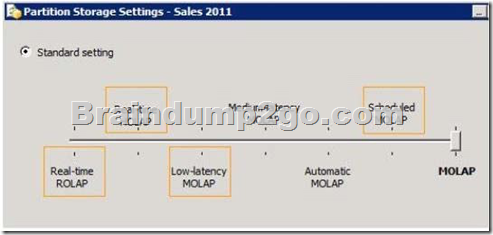
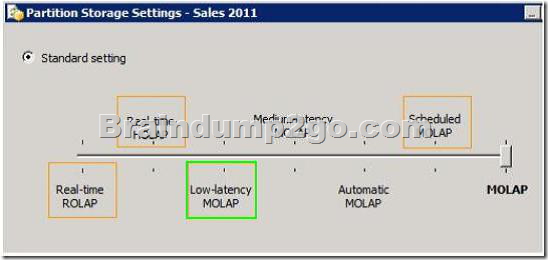
![1[9] 1[9]](http://examgod.com/bdimages/1d0d4780ce23_E070/19.png)
Comments are currently closed.